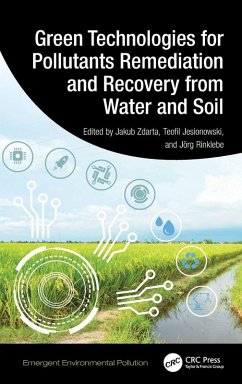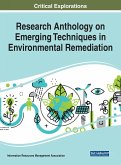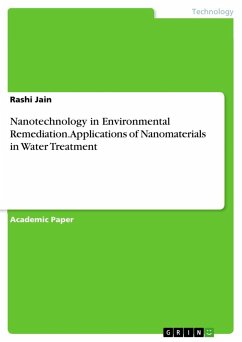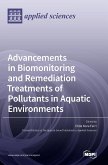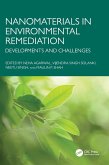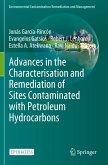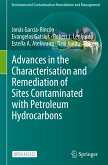Green Technologies for Pollutants Remediation and Recovery from Water and Soil
Herausgeber: Zdarta, Jakub; Rinklebe, Jörg; Jesionowski, Teofil
Green Technologies for Pollutants Remediation and Recovery from Water and Soil
Herausgeber: Zdarta, Jakub; Rinklebe, Jörg; Jesionowski, Teofil
- Gebundenes Buch
- Merkliste
- Auf die Merkliste
- Bewerten Bewerten
- Teilen
- Produkt teilen
- Produkterinnerung
- Produkterinnerung
Green Technologies for Pollutants Remediation and Recovery from Water and Soil presents a comprehensive examination of sustainable and environmentally friendly methods for remediation and recovery from various types of pollutants in water bodies and in soil.
Andere Kunden interessierten sich auch für
![Research Anthology on Emerging Techniques in Environmental Remediation Research Anthology on Emerging Techniques in Environmental Remediation]() Research Anthology on Emerging Techniques in Environmental Remediation421,99 €
Research Anthology on Emerging Techniques in Environmental Remediation421,99 €![Nanotechnology in Environmental Remediation. Applications of Nanomaterials in Water Treatment Nanotechnology in Environmental Remediation. Applications of Nanomaterials in Water Treatment]() Rashi JainNanotechnology in Environmental Remediation. Applications of Nanomaterials in Water Treatment16,95 €
Rashi JainNanotechnology in Environmental Remediation. Applications of Nanomaterials in Water Treatment16,95 €![Advancements in Biomonitoring and Remediation Treatments of Pollutants in Aquatic Environments Advancements in Biomonitoring and Remediation Treatments of Pollutants in Aquatic Environments]() Advancements in Biomonitoring and Remediation Treatments of Pollutants in Aquatic Environments89,99 €
Advancements in Biomonitoring and Remediation Treatments of Pollutants in Aquatic Environments89,99 €![Nanomaterials in Environmental Remediation Nanomaterials in Environmental Remediation]() Nanomaterials in Environmental Remediation205,99 €
Nanomaterials in Environmental Remediation205,99 €![Sustainable Management of Environmental Pollutants through Phytoremediation Sustainable Management of Environmental Pollutants through Phytoremediation]() Sustainable Management of Environmental Pollutants through Phytoremediation115,99 €
Sustainable Management of Environmental Pollutants through Phytoremediation115,99 €![Advances in the Characterisation and Remediation of Sites Contaminated with Petroleum Hydrocarbons Advances in the Characterisation and Remediation of Sites Contaminated with Petroleum Hydrocarbons]() Advances in the Characterisation and Remediation of Sites Contaminated with Petroleum Hydrocarbons31,99 €
Advances in the Characterisation and Remediation of Sites Contaminated with Petroleum Hydrocarbons31,99 €![Advances in the Characterisation and Remediation of Sites Contaminated with Petroleum Hydrocarbons Advances in the Characterisation and Remediation of Sites Contaminated with Petroleum Hydrocarbons]() Advances in the Characterisation and Remediation of Sites Contaminated with Petroleum Hydrocarbons38,99 €
Advances in the Characterisation and Remediation of Sites Contaminated with Petroleum Hydrocarbons38,99 €-
-
-
Green Technologies for Pollutants Remediation and Recovery from Water and Soil presents a comprehensive examination of sustainable and environmentally friendly methods for remediation and recovery from various types of pollutants in water bodies and in soil.
Produktdetails
- Produktdetails
- Verlag: CRC Press
- Seitenzahl: 300
- Erscheinungstermin: 29. September 2025
- Englisch
- Abmessung: 240mm x 161mm x 21mm
- Gewicht: 617g
- ISBN-13: 9781032881218
- ISBN-10: 1032881216
- Artikelnr.: 73327960
- Herstellerkennzeichnung
- Libri GmbH
- Europaallee 1
- 36244 Bad Hersfeld
- gpsr@libri.de
- Verlag: CRC Press
- Seitenzahl: 300
- Erscheinungstermin: 29. September 2025
- Englisch
- Abmessung: 240mm x 161mm x 21mm
- Gewicht: 617g
- ISBN-13: 9781032881218
- ISBN-10: 1032881216
- Artikelnr.: 73327960
- Herstellerkennzeichnung
- Libri GmbH
- Europaallee 1
- 36244 Bad Hersfeld
- gpsr@libri.de
Dr. Jakub Zdarta is an associate professor in the Faculty of Chemical Technology and Engineering, Poznan University of Technology, Poland. He is a member of the editorial boards of the journals Environmental Technology & Innovations, Catalysis Communications, Oxygen, and AIMS Bioengineering. He has been a guest editor for several special issues from different journals. His research is focused on environmental biotechnology and the removal of environmental pollutants for which he has published many articles and received several awards. Dr. Teofil Jesionowski is currently the Rector of Poznan University of Technology, Poland. He is a chemist and engineer, and he graduated from the same university. His areas of research include polymer modification, neutralization of water pollution with inorganic and organic compounds. Many of his scientific studies also concern the development of the so-called "Green Chemistry". Dr. Jörg Rinklebe is a professor of soil and groundwater management at the University of Wuppertal, Germany. He is internationally recognized for his research in the areas of biogeochemistry of trace elements in wetland soils. Dr. Rinklebe has published over 500 research papers, four books, as well as numerous book chapters. He is the Editor of the international journal Critical Reviews in Environmental Science and Technology (CREST). He is a Visiting Professor at the Department of Environment, Energy and Geoinformatics at Sejong University, Seoul, South Korea, and Guest Professor at the Department of Environmental Engineering, China Jiliang University, Hangzhou, Zhejiang, China. Recently, Dr. Rinklebe was elected as Vice President of the International Society of Trace Element Biogeochemistry (ISTEB).
1. Progressing Forward: Sustainable Remediation and Recovery of Pollutants.
2. Green Strategies for Removal of Emerging Contaminants from Aqueous
System: A Promising Approach for Sustainable Future. 3. Green Solutions the
Removal of Pharmaceutics Removal from Wastewater. 4. Advancing
Biotechnology Towards Pollutant Recirculation and Recovery in a Changing
World. 5. The Potential of Biocatalysts for Pollutant Removal: Efficient
Remediation and Toxicity Removal. 6. Microbiomes in Fight with Pollutant
Remediation: From Single Strain to Omics-Approach to Bioremediation. 7.
Biomass Production: A Sustainable Approach for Waste Recovery and its
Conversion into New Products. 8. Sustainable Biomass Production from
Microalgae Using Biorefinery Approach: New Prospects and Challenges. 9.
Linking Microalgae-based Processes and Conversion of Water Pollutants for
Valuable Compounds Obtaining. 10. Advances in the use of Membrane
Technology for Efficient Removal of Pollutants from Water Bodies. 11.
Application and Research Progress of Hydrochar in Nutrient Recovery from
Livestock Manure Wastewater. 12. Computational Environmental Chemistry as a
Strategy for Remediation. 13. Iron Oxides-based Technologies for
Remediation of Arsenic/Chromium Contaminated Soils.
2. Green Strategies for Removal of Emerging Contaminants from Aqueous
System: A Promising Approach for Sustainable Future. 3. Green Solutions the
Removal of Pharmaceutics Removal from Wastewater. 4. Advancing
Biotechnology Towards Pollutant Recirculation and Recovery in a Changing
World. 5. The Potential of Biocatalysts for Pollutant Removal: Efficient
Remediation and Toxicity Removal. 6. Microbiomes in Fight with Pollutant
Remediation: From Single Strain to Omics-Approach to Bioremediation. 7.
Biomass Production: A Sustainable Approach for Waste Recovery and its
Conversion into New Products. 8. Sustainable Biomass Production from
Microalgae Using Biorefinery Approach: New Prospects and Challenges. 9.
Linking Microalgae-based Processes and Conversion of Water Pollutants for
Valuable Compounds Obtaining. 10. Advances in the use of Membrane
Technology for Efficient Removal of Pollutants from Water Bodies. 11.
Application and Research Progress of Hydrochar in Nutrient Recovery from
Livestock Manure Wastewater. 12. Computational Environmental Chemistry as a
Strategy for Remediation. 13. Iron Oxides-based Technologies for
Remediation of Arsenic/Chromium Contaminated Soils.
1. Progressing Forward: Sustainable Remediation and Recovery of Pollutants.
2. Green Strategies for Removal of Emerging Contaminants from Aqueous
System: A Promising Approach for Sustainable Future. 3. Green Solutions the
Removal of Pharmaceutics Removal from Wastewater. 4. Advancing
Biotechnology Towards Pollutant Recirculation and Recovery in a Changing
World. 5. The Potential of Biocatalysts for Pollutant Removal: Efficient
Remediation and Toxicity Removal. 6. Microbiomes in Fight with Pollutant
Remediation: From Single Strain to Omics-Approach to Bioremediation. 7.
Biomass Production: A Sustainable Approach for Waste Recovery and its
Conversion into New Products. 8. Sustainable Biomass Production from
Microalgae Using Biorefinery Approach: New Prospects and Challenges. 9.
Linking Microalgae-based Processes and Conversion of Water Pollutants for
Valuable Compounds Obtaining. 10. Advances in the use of Membrane
Technology for Efficient Removal of Pollutants from Water Bodies. 11.
Application and Research Progress of Hydrochar in Nutrient Recovery from
Livestock Manure Wastewater. 12. Computational Environmental Chemistry as a
Strategy for Remediation. 13. Iron Oxides-based Technologies for
Remediation of Arsenic/Chromium Contaminated Soils.
2. Green Strategies for Removal of Emerging Contaminants from Aqueous
System: A Promising Approach for Sustainable Future. 3. Green Solutions the
Removal of Pharmaceutics Removal from Wastewater. 4. Advancing
Biotechnology Towards Pollutant Recirculation and Recovery in a Changing
World. 5. The Potential of Biocatalysts for Pollutant Removal: Efficient
Remediation and Toxicity Removal. 6. Microbiomes in Fight with Pollutant
Remediation: From Single Strain to Omics-Approach to Bioremediation. 7.
Biomass Production: A Sustainable Approach for Waste Recovery and its
Conversion into New Products. 8. Sustainable Biomass Production from
Microalgae Using Biorefinery Approach: New Prospects and Challenges. 9.
Linking Microalgae-based Processes and Conversion of Water Pollutants for
Valuable Compounds Obtaining. 10. Advances in the use of Membrane
Technology for Efficient Removal of Pollutants from Water Bodies. 11.
Application and Research Progress of Hydrochar in Nutrient Recovery from
Livestock Manure Wastewater. 12. Computational Environmental Chemistry as a
Strategy for Remediation. 13. Iron Oxides-based Technologies for
Remediation of Arsenic/Chromium Contaminated Soils.

